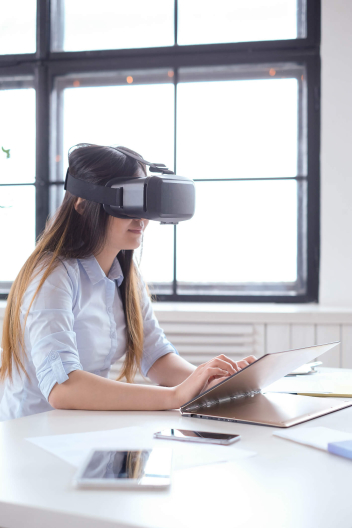COVID-19 sparked rapid changes in our civilization, especially our social and educational institutions. Working from home, studying remotely, and having our groceries delivered became our everyday reality. We normalized voluntary confinement in our homes.
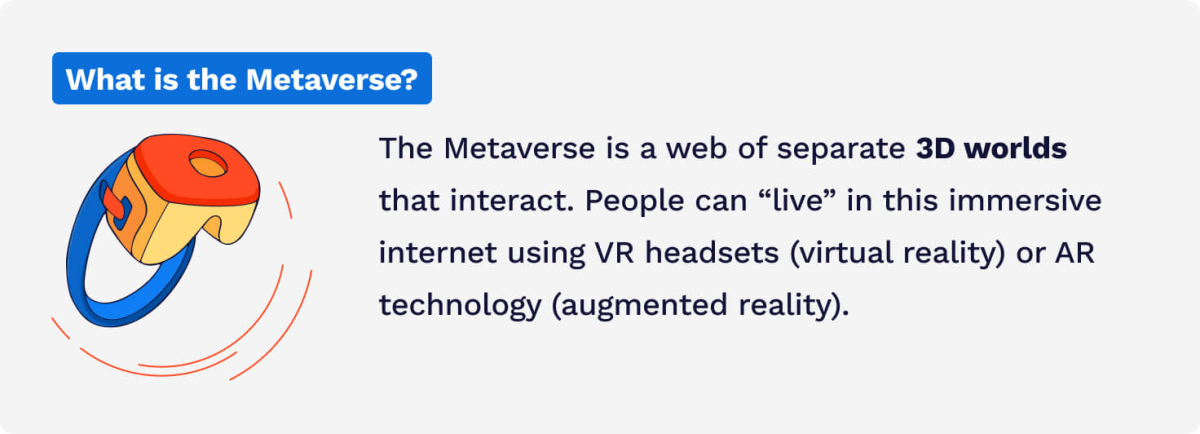
At the same time, we began to notice the lack of realistic experiences and in-person communication. Some people have opted for downshifting, moving to the country, and rejecting technology. Others for whom this article is intended are choosing virtual reality and the Metaverse.
The Metaverse is one of the most controversial topics in modern technology. It is believed to be the next step in the development of the World Wide Web. Some even expect it to become a breakthrough innovation that changes our understanding of education and skill development.
Many companies have poured money into the Metaverse, including Facebook, but the current state of technology remains imperfect. Bill Gates sees nothing particularly revolutionary in the technology. Zuckerberg told his investors that generations might pass before people get used to living in virtual worlds.
Will the technology become as ground-breaking as the invention of a web browser? Or will our grandchildren recall it as a passing fad? Time will tell.
🕹️ What Is the Metaverse & Why Does It Matter?
So, what is the Metaverse?
The Metaverse is a web of separate, virtual 3D worlds that interact. People can “live” in these worlds using VR headsets (virtual reality) or AR technology (augmented reality).
Small sections of these futuristic worlds already exist, and people even call some of them “metaverses.” But this would be like claiming that your local university network is the entire internet.
Like any ground-breaking technology, the Metaverse has believers and skeptics who often engage in spirited debates (fueled by interested corporations, with Facebook high in the ranks).
People who believe VR has a bright future claim that the Metaverse will be supported by its own digital economy (blockchain technology). VR atheists remind us of the significant investments without which digital reality cannot exist.
Indeed, the Metaverse is a controversial achievement, at least for now. Consider these three facts:
- Surprisingly, 47% of Americans aged 13 to 70 can describe the Metaverse based on their user experiences. In other words, half of Americans have tried VR (but might not have liked it).
- Horizon Worlds, a free online VR game, failed to demonstrate its expected growth or even retain consumer interest. It is important to mention that Meta Platforms, commonly known as Facebook, is the game’s developer. If Facebook can’t get people hooked on the Metaverse, then who can?
- People have seen only the “building blocks” that haven’t been connected to the real Metaverse. We just don’t know what the real Metaverse may bring us.
📖 A Brief History of the Metaverse
A surprising fact: the invention of the Metaverse is not as recent as we might think. As with any other huge shift in human civilization, this tipping point arose after many other innovations.
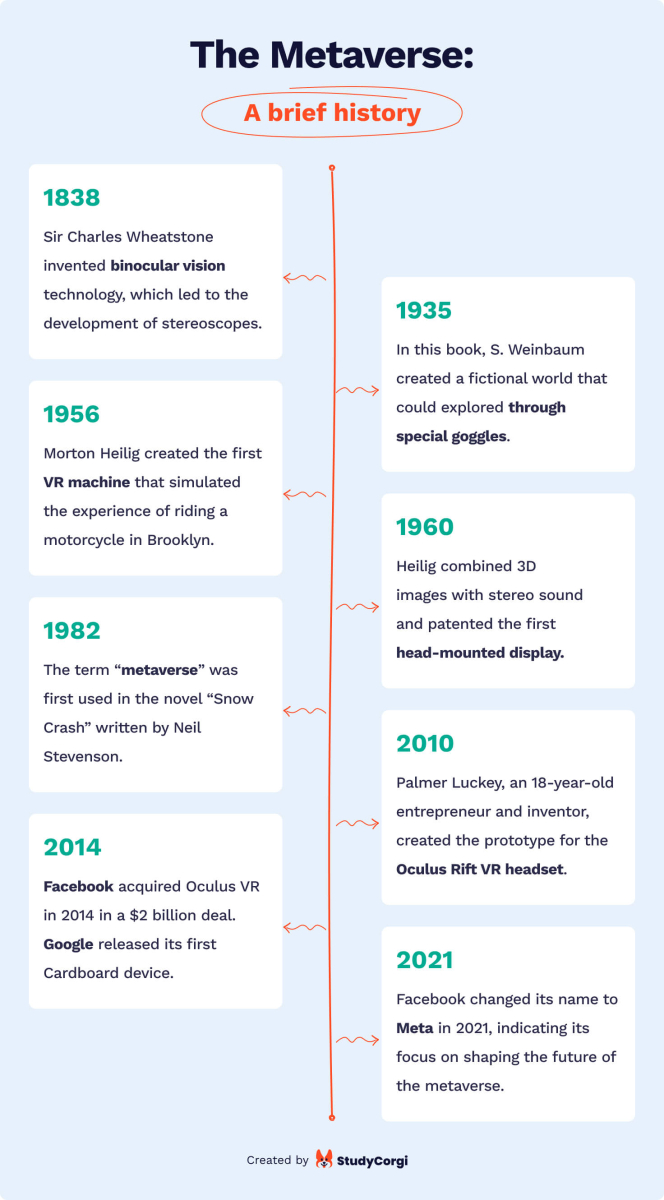
The Key Events in the Metaverse History
🆚 The Metaverse & VR: What’s the Difference?
The term “Metaverse” is so vague that there is no unanimous definition, even among those who have invested time and money into VR worlds. Mark Zuckerberg believes it to be the future of the internet, and Satya Nadella describes it as a new version of the good old Zoom.
In fact, if you replace “Metaverse” with “Cyberspace,” you’ll probably won’t notice the difference.
Are the terms too young to have a definite meaning? Or are they too generic and speculative? It’s highly likely that the terms may eventually become outdated. And once the specific technology becomes commonplace (in its future form, which we can’t imagine now), a new word will probably be coined.
At the moment, the Metaverse includes virtual and augmented reality. Both continue to exist when you are not playing, and both combine the traits of the digital and physical worlds.
However, the developers of virtual worlds (Minecraft, Fortnite, World of Warcraft, and others) often refer to themselves as “metaverses,” worsening the confusion. This is like Google or Meta calling themselves the “internet.”
What we know for sure is that VR is an existing technology with clear and tangible features. It will continue to develop and evolve into something humanity has never seen before.
The Metaverse, on the contrary, is a futuristic utopian amalgamation. It is our projection of a mix of science fiction and the available technology. But without delving too far into fantasy, it can be inspiring to think like Jules Verne: “Anything that one man can imagine, other men can make real.”
However, until researchers find a way to unite everyone in the same virtual world, we will focus on VR and its influence on contemporary education.
💻 The Metaverse & VR in Education
Virtual reality combines computerized technology and devices that create a simulated environment. The viewer can see the image and feel as if they were a part of the virtual world thanks to lights, different 3D techniques, and sound effects.
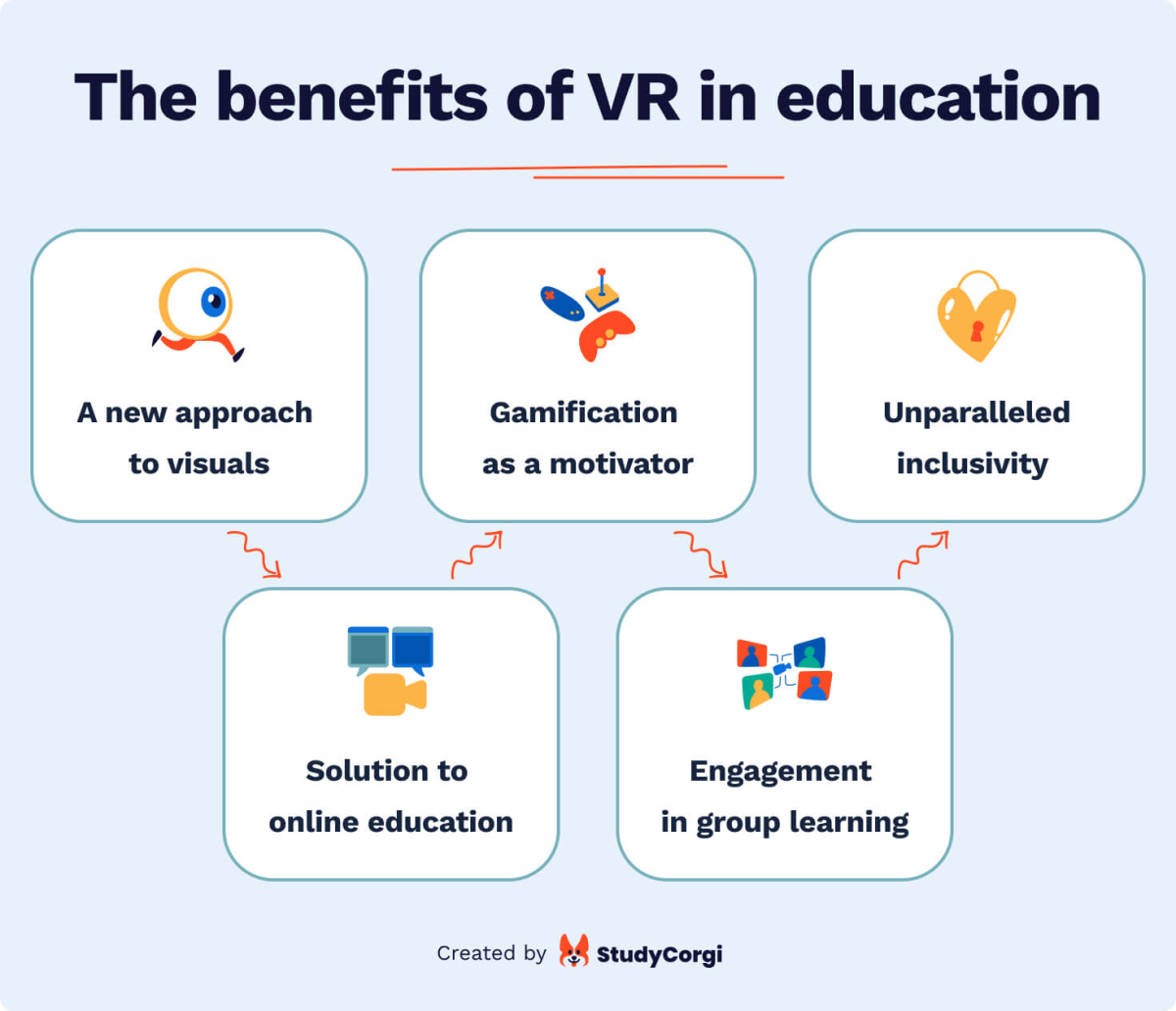
Although no technology can replace human interaction, VR can improve and accelerate it. It is an excellent educational tool that provides live experiences and real-time practice. Instead of tedious lectures, students can actively interact with teachers and objects in the visual scene.
Consider these benefits:
Ways to Use the Metaverse in the Educational System
The potential applications of the Metaverse and VR in education are endless. Still, the following opportunities are the most obvious at the moment.
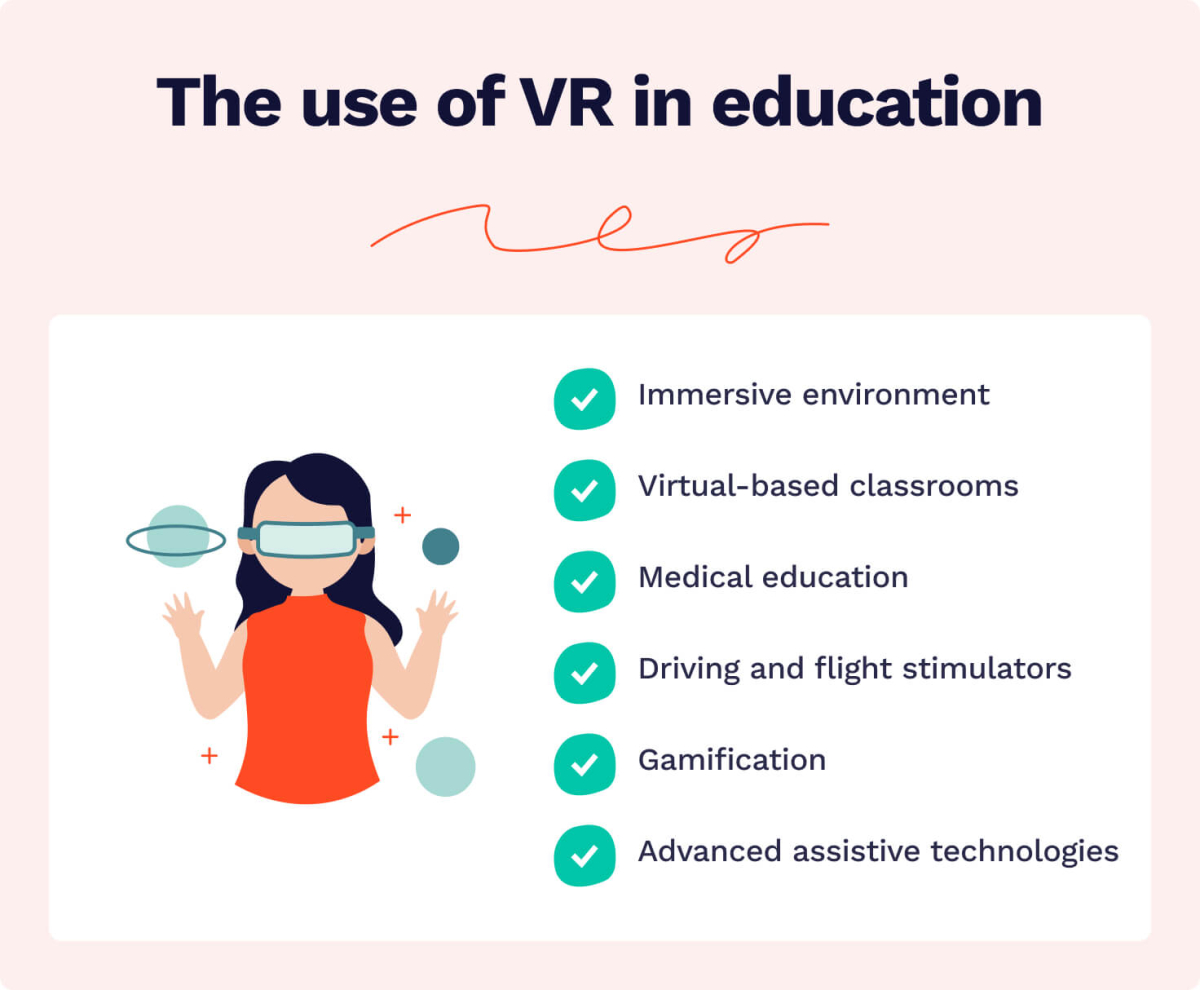
Immersive Educational Environment
Advanced educational programs have combined science, technology, engineering, and math under the STEM abbreviation. One of the key reasons for doing so is that they all use the same practical teaching methods.
The Metaverse will immerse students in multimedia environments to leverage physical and digital realities.
For instance, one can learn geometric equations by manipulating VR geometric shapes while listening to the context and guidance given by the mathematician. Studying astrology, biology, anatomy, geography, and physics will also become much easier and more engaging.
Tutors can converse with students in the physical environment to review their progress or help resolve a theoretical problem. The Metaverse will blend the physical and virtual worlds to provide diverse learning opportunities in a collaborative setting.
Virtual-Based Classrooms
The biggest problem in any educational system is the percentage of information that students miss out on because they’re not paying attention. It often happens because the content can be found by simply typing the topic into a Google search bar. Students usually ask themselves, “Why should I listen to the teacher if I can find this information on the web?”
VR gives learners the feeling of being connected or involved. They can socialize with avatars, discover new topics, and find “easter eggs” in the visual learning environment.
Unlike VR lessons, traditional approaches constrain students to a specific location. Now, textbooks and whiteboards are gradually fading away. Teachers and students can interact and participate in extracurricular activities even without being in the same room. Moreover, students can connect whenever they wish from any location. This makes education accessible to everyone.
Medical Education
Did you know that cadavers are still the primary source of practice for medical students? Ethical issues aside, dissection teaches them to detach, work as a team, and develop a sense of curiosity.
Before now, this has been the only way to train future surgeons. But corpses don’t have blood pressure and cannot create a “live” experience of surgery.
The research has found that virtual surgery rooms can improve the performance of future medical staff by 29% and decrease the risk of mistakes by six times.
And these figures become more impressive once we recall they can save human lives.
Driving and Flight Stimulators
VR devices have been a part of standard pilot and astronaut training for years.
VR offers a perfectly simulated environment with real-time feelings. These instruments develop the students’ visual architectural structures and teach them to analyze the factors in a stressful situation. Meanwhile, they prevent accidents during first-time flights since VR training takes place on the ground in total safety.
Some vehicle drivers are also trained with VR tools. Developers from the United Parcel Service have created the HTC Vive platform that simulates collisions with obstacles and other dangerous road situations. Going through these scenarios can teach future drivers valuable lessons.
Gamification
Learning is already becoming gamified. VR learning increasingly includes game-design elements (competition, points, and rewards). Immersive VR and AR worlds can go beyond the limitations of 2D games.
Gamified elements are increasingly more immersive and popular among young people. The global game-based educational market is expected to increase by nearly 20% in the next five years. Roblox, a popular gaming environment for kids, has about 55 million users daily.
2D educational games are still popular with students and teachers. Kahoot! is an excellent example.
Games are all around us. Virtual reality is just the next level.
Advanced Assistive Technologies
Students with disabilities can significantly improve their studying experience when teachers use technology in the classroom.
Virtual reality apps can teach students with special needs something more than just figures and theories. They can develop social, safety, conversational, and other everyday skills. Students can practice realistic scenarios in a safe and convenient environment without the risk of entering an uncontrolled reality.
Shopping at a grocery store, visiting a public restroom, or getting a haircut can be incredibly overwhelming for people with autism. But now they can master these skills at their own pace.
More than ever, special needs teachers can engage their students using assistive technologies. Their students also benefit from staying current with technological advances and enjoying a comfortable classroom environment.
🚫 VR in Education: Drawbacks & Challenges
Education has not fully embraced virtual reality for several reasons.
- Cost. Building and maintaining an entire educational system using VR would be very expensive, even for private schools. For public institutions, the cost is prohibitive.
- Regulation. VR raises multiple regulatory and legal issues, particularly in terms of education. These include data security, personal privacy, and virtual property. These issues need to be tackled before a widespread introduction of the technology.
- Conservatism. VR will only become commonplace at colleges after it is an everyday reality elsewhere. Meanwhile, some people may reject the idea of turning education into a game.
- Escapism. VR is immersive and alluring. It can be addictive and drive students into escapism. Students may be tempted to spend unlimited time in VR at the expense of their real lives, even if their everyday activities will develop them professionally.
- Inequality. Unfortunately, some students will not have the opportunity to purchase an expensive headset or study at a college that provides them. VR can increase the gap between the rich and the poor. For example, students who graduated from institutions that use the technology may be more competitive in the job market. Still, this drawback remains unproven for now.
🎮 What Do I Need for VR?
- A headset is an essential piece of a VR kit. A thick pair of goggles is the intermediary between your eyes and the computer. Expensive headsets provide a higher quality experience but need to be connected to a computer. Cheaper ones can even have a cell phone attached to the headset.
- Headphones ensure that the picture is accompanied by high-quality sound.
- Hand controllers, treadmills, and other optional accessories enhance the simulated experience.
- Software is the brain of the process. Some VR devices are serviced by their own app stores (similar to Google Play or App Store), while others require purchasing external programs.
As you can see, everything depends on the headset and its features. Here’s a brief list of the trending devices.
Valve Index
The Valve Index is currently the best VR headset. It has an unparalleled display quality, wide field of view, high refresh rate, and highly sensitive controllers that track the movement of your fingers. Its only drawback is the price, as compared to its competitors.
Meta Quest 2
This would be the best choice for most people since it has everything a headset should have while still remaining affordable. And unlike many other budget headsets, this one doesn’t rely on a smartphone or PC, making it a completely standalone solution.
Nintendo Labo VR Kit
This cardboard extension kit for Nintendo Switch is a perfectly customizable option. Besides, it is excellent for a younger audience that is only getting started with VR. It contains several cardboard creations that friends or siblings can share. But like other paper variants, they project pixelated graphics.
Google Cardboard
Google Cardboard is the most affordable way to immerse yourself in virtual reality. You just need to find a style that fits your smartphone and insert the device into the cardboard structure. This option was introduced in 2014 but is still prevalent.
DIY
With some time and effort, you can build your own VR headset. You’ll need a couple of everyday items you can find at home, online, or even at a local hardware store:
- Cardboard
- Lense
- Magnets
- Hook and loop fastener
- Rubber band
📱 Top 5 Educational VR Apps to Try Right Now
VR can be applied in a variety of disciplines. Check out the apps below for key subjects.
Virtual reality cannot resolve all the existing issues in a learning environment, but its application can lower the incidence of students’ demotivation, distraction, and disinterest. Every innovation is frightening at the beginning because it brings the illusion of omnipotence. Still, new technologies move us towards a better world with equal opportunities for all.
Please share your experience of using VR in education in the comments below.
